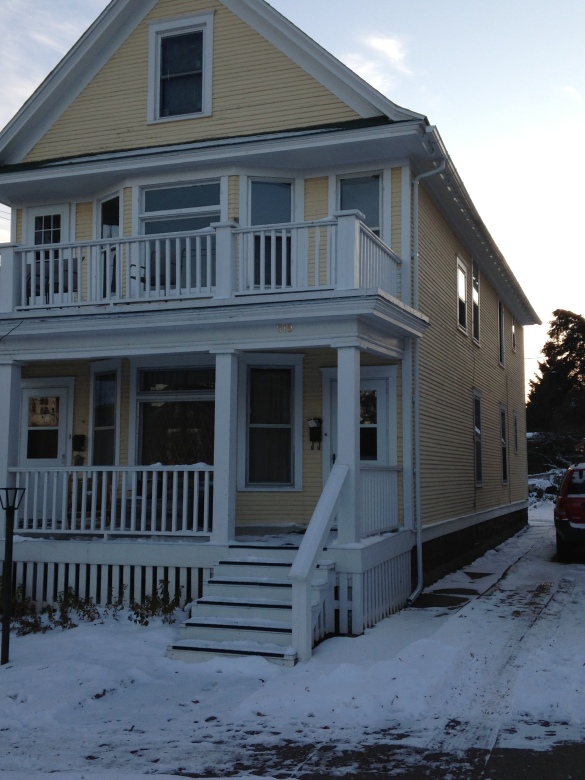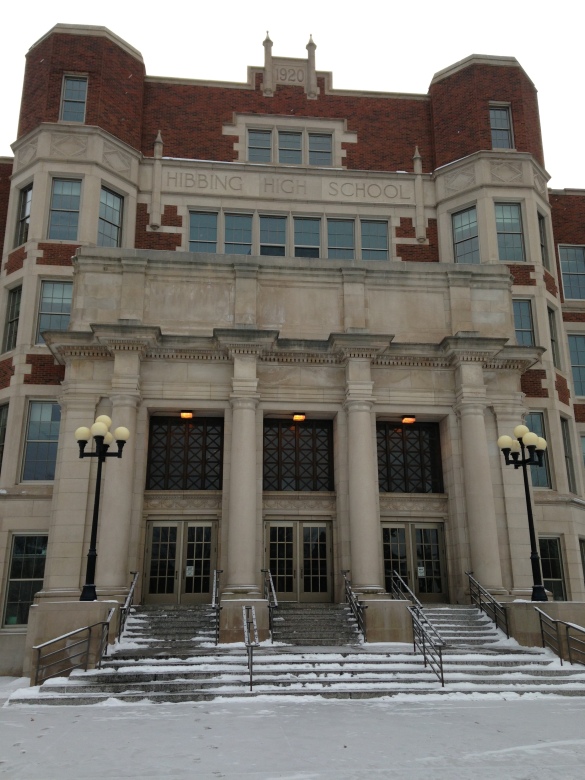
On a bleak, wintry weekend in November of 2014, my brother and I made a pilgrimage to “the north country fair, where the winds hit heavy on the borderline” in search of the roots of Bob Dylan. It was an unforgettable trip that richly increased my understanding of the mysterious forces that shaped a relatively ordinary teenager in the Minnesota town of Hibbing and helped turn him into the Shakespeare of our age.
We set out Friday morning from my brother’s home in Thunder Bay. Once across that “borderline”, we travelled south along Highway 61 (Revisited). There was no sign of a promoter putting some bleachers out in the sun. We were soon in Duluth, where Dylan was born as Robert Allen Zimmerman 80 years ago, on May 24, 1941, six months or so before Pearl Harbour. The future Nobel Prize winner was brought home to the second floor of a modest, wood- frame duplex rented by his parents Abe and Beatty, not far up the hill from downtown Duluth.

The Lake Superior port city had been more interesting in the old days, when it was a hotbed of socialism, full of Wobblies, Red Finns and immigrant workers from all over Europe. In 2014, although admittedly difficult for any northern city to show its best in November, there seemed a sense of decay in the city’s historic downtown area. Many of its fine, early 20th century buildings were caked in grime. Few pedestrians braved the late afternoon chill.
The Zimmerman’s lived in Duluth tuntil Dylan was six, when they moved 70 miles north to Hibbing. But the city was not without its influences. In his engrossing memoir, Chronicles, Dylan recalled hearing “the heavy rumble of the foghorns (of the big lake freighters that) dragged you out of your senses by the neck….As a child, slight, introverted and asthma-stricken, the sound was so loud, so enveloping, I could feel it in my whole body and it made me feel hollow. Something out there could swallow me up.”
Duluth also has an enormous armoury, where popular, touring performers of the day made regular appearances. On Jan. 31, 1959, Dylan and some friends made the trip down from Duluth to catch Buddy Holly’s Winter Dance Party tour at the Armoury. Three days later, the life of the much-loved, young rock star was cut short in a plane crash, along with Ritchie Valens and the Big Bopper. Dylan has often mentioned their appearance in Duluth as a pivotal moment in his life. Accepting Album of the Year at the 1998 Grammys for Time Out Of Mind, he said: “I just want to say that when I was 16 or 17 years old, I went to see Buddy Holly play at Duluth National Guard Armory and I was three feet away from him… and he looked at me. And I just have some kind of feeling that he was – I don’t know how or why – but I know he was with us all the time we were making this record in some kind of way.”
And finally, the startling first verse of Dylan’s dense, 11-minute masterpiece, Desolation Row, is not based, as I thought for many years, on one of his incomparable, dream-like images, but on a real event that took place in Duluth, not far from where the Zimmermans lived. In 1920, three Black employees of a touring circus were strung up from a corner lamp post on the mistaken belief they had raped a white girl. A grisly photo of the mob posing with the corpses was made into a postcard. One of Dylan’s uncles remembered seeing it as a youth. The incident is commemorated in Desolation Row. “They’re selling postcards of the hanging/They’re painting the passports brown/The beauty parlor is filled with sailors/The circus is in town.” My brother and I visited a haunting memorial to the three innocent Blacks where the lynchings took place. I wrote about it all in a previous Mickleblog. https://mickleblog.wordpress.com/tag/desolation-row/
Then it was off to Hibbing. With its oddball name and nowhere locale, Dylan’s hometown had taken on a magical air in my imaginings for so many years. I mean, did Hibbing even exist?
Our first step was Hibbing High School. With its marble staircase, brass handrails and large imposing pillars adorning the school’s entranceway, it was unlike any high school I had ever seen. The enormous, sprawling structure, built in 1920 for $4 million, is considered an especially opulent example of Jacobethan architecture and was soon known as ‘the castle in the woods”. But what the heck was this huge, costly citadel of education doing in nondescript Hibbing? Apparently, the school’s design and construction was financed by local mining interests who wanted to entice immigrant labourers by displaying their commitment to a good education for their children.

The school’s vast interior includes an absurdly large, 1,800 seat auditorium with crystal chandeliers. The auditorium is legendary in Dylan lore as the place where a garage band fronted by student Robert Zimmerman pounded out 1950s rock and roll at a school assembly, until the principal could stand the noise no longer and pulled the plug. In a wry assessment 30 years later, Dylan scholar Stephen Scobie of Victoria observed: “Every stage Bob Dylan has played on since has been, after Hibbing High School Auditorium, an anticlimax.”
We peered through the glass-paned front doors at the stairs leading to the darkened hallways and rows of lockers, enjoying thoughts of how familiar it would have been to the teen-aged Dylan. From most accounts he enjoyed life at Hibbing High School, signing up for the Latin and Social Studies Club and citing his ambition in the high school yearbook “to join Little Richard”. The photo of a very unwaif-like Dylan is sandwiched between too other end-of-the-alphabet students, Barbara Yeshe and Shirley Zubich.
Dylan didn’t have far to walk to high school. His house, with its distinctive flat-topped roof, was just two blocks away at 2425 7th Ave., now renamed Bob Dylan Drive. For Dylan fanatics, this is the mother-lode, his home for a dozen years until leaving in 1959 for the University of Minneapolis. A mere two years after that, he had written Blowin’ In the Wind, A Hard Rain’s A-Gonna Fall, Girl From the North Country and fame was nigh. Under the pale winter sun, the nicely re-painted, stucco house seemed deserted. Front steps and sidewalk were unshovelled. Icicles hung from the eaves. I looked up at the windows of Bob’s bedroom on the second floor. He said, once: “In the winter, everything was still, nothing moved. Eight months of that…you can have some amazing hallucinogenic experiences doing nothing but looking out your window.” My brother and I posed for pictures, and left, reluctantly.

We hit Hibbing’s desolate downtown Sunday morning. Wisps of snow blew up and down the town’s wide main drag, Howard Street. The names of the storefronts had changed, but the streetscape seemed little different from what it must have been like during Dylan’s time. Here were the pizza joint, record store, juke box cafés, movie theatre and small department stores that he grew up with. Most are long gone, given the shopping malls that have sapped business from main streets everywhere. But the vintage bowling alley where Bob bowled is still there. So too is the massive Androy Hotel, now an apartment building for seniors (no, Bob isn’t moving in…), where his bar mitzvah was held. Alas, Zimmy’s, a cabaret-style bar that had hoped to capitalize on Dylan’s Hibbing connections, had gone out of business.

We ended our pilgrimage with a short trip out of town to the reason for Hibbing’s existence, the largest open-pit iron mine in the world. Pictures don’t do justice to its enormity, said to be three miles wide and 500 feet deep. Huge earthmovers in the distance were dwarfed by the sheer size of the mine. Being Sunday, nothing moved. It was quiet, except for the whistling of the bitterly-cold wind. One sensed the ghosts of previous miners and the cyclical boom and bust of their fortunes. Five years after leaving Hibbing, Dylan wrote and recorded North Country Blues, a moving song about the desperate plight of an iron miner’s wife, left to care for three children after a mine shutdown. Joan Baez does a beautiful cover of the song. https://www.youtube.com/watch?v=m0XUfoLkG0o

As we headed back to Thunder Bay, making sure to stop at the site of the “World’s Largest Free-Standing Hockey Stick” in self-styled Hockeytown, USA (aka Eveleth), I felt I had a much deeper sense of how Dylan came to be. Growing up in the north, in an isolated place like Hibbing, cut off from “big city” distractions, with long winters and characteristics uniquely its own, he must have acquired a sensibility and way of looking at the world he might never have had if, say, he had grown up in a place like summery San Diego. That was hammered home from my first look at Hibbing’s forlorn but singular main street, followed by the scarred landscape of its open-pit mine, both in the teeth of November. Despite many elements that could be found anywhere in the USA, Hibbing was not a small town like the others. And it gave us the greatest songwriter of our era.
At 23, Dylan acknowledged his roots as part of his under-rated 11 Outlined Epitaphs on the back cover of The Times They Are A-Changing. Referring to Hibbing, he wrote: “the town I grew up in is the one that has left me with my legacy visions/it was not a rich town/my parents were not rich/it was not a poor town/an my parents were not poor/it was a dyin town/…..I know I shall meet the snowy North again/but with changed eyes nex time round/t walk lazily down its streets/an linger by the edge of town/find old friends if they’re still around/talk t the old people/an the young people/running yes. . ./but stopping for a while/embracing what I left/an loving it—for I learned by now/never t expect/what it can not give me/”

What an excellent story Rod! Thanks!
thanks, Kris! Hope you’re hanging in there….
Very nice, Rod.
Thanks, Bob….much appreciated…..Parkins liked it, too 🙂
Cool pilgrimage!
Gee, thanks, Terry….us old timers are still kicking….hehe
Choice.
thank you!
Nicely done, Rod. Can’t wait for your trip to Tulsa.
Thanks, Paul…but maybe Lowell, Massachusetts….hehe
All great story, but Mickle of B.C , what about Duncan, B.C’s. BIGGEST hockey stick
you will notice that the claim is very carefully-worded…..the world’s largest “free-standing” hockey stick, do deal with Duncan’s presumption….will send you a photo….
Excellent nostalgia commentary about your road trip–something I bet a lot of us have wanted to do. Quite a few years ago, I took a side trip to Luckenbach, Texas, to see where Willie and Waylon and their friends hung out in the 70s. It wasn’t crowded (population 3).